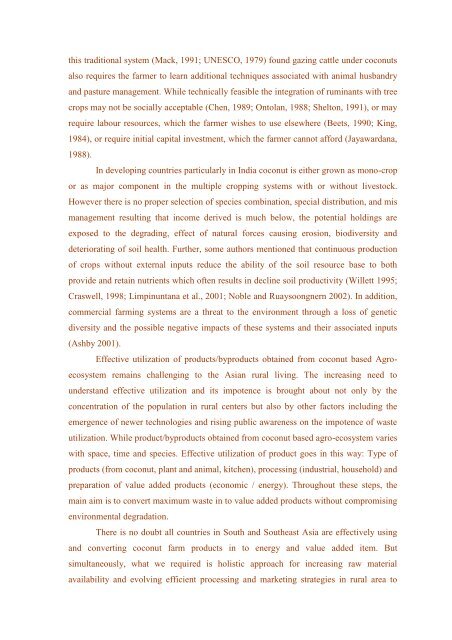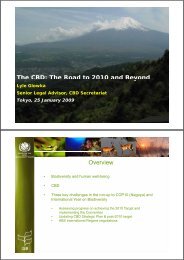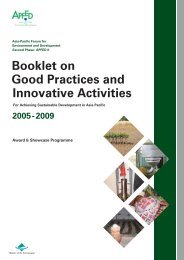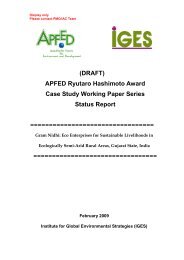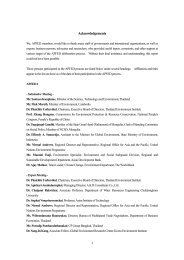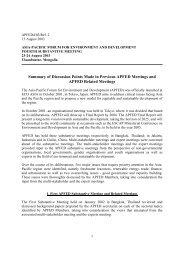Case Study Report on Promoting Coconut Based Agro ... - APFED
Case Study Report on Promoting Coconut Based Agro ... - APFED
Case Study Report on Promoting Coconut Based Agro ... - APFED
Create successful ePaper yourself
Turn your PDF publications into a flip-book with our unique Google optimized e-Paper software.
this traditi<strong>on</strong>al system (Mack, 1991; UNESCO, 1979) found gazing cattle under coc<strong>on</strong>uts<br />
also requires the farmer to learn additi<strong>on</strong>al techniques associated with animal husbandry<br />
and pasture management. While technically feasible the integrati<strong>on</strong> of ruminants with tree<br />
crops may not be socially acceptable (Chen, 1989; Ontolan, 1988; Shelt<strong>on</strong>, 1991), or may<br />
require labour resources, which the farmer wishes to use elsewhere (Beets, 1990; King,<br />
1984), or require initial capital investment, which the farmer cannot afford (Jayawardana,<br />
1988).<br />
In developing countries particularly in India coc<strong>on</strong>ut is either grown as m<strong>on</strong>o-crop<br />
or as major comp<strong>on</strong>ent in the multiple cropping systems with or without livestock.<br />
However there is no proper selecti<strong>on</strong> of species combinati<strong>on</strong>, special distributi<strong>on</strong>, and mis<br />
management resulting that income derived is much below, the potential holdings are<br />
exposed to the degrading, effect of natural forces causing erosi<strong>on</strong>, biodiversity and<br />
deteriorating of soil health. Further, some authors menti<strong>on</strong>ed that c<strong>on</strong>tinuous producti<strong>on</strong><br />
of crops without external inputs reduce the ability of the soil resource base to both<br />
provide and retain nutrients which often results in decline soil productivity (Willett 1995;<br />
Craswell, 1998; Limpinuntana et al., 2001; Noble and Ruayso<strong>on</strong>gnern 2002). In additi<strong>on</strong>,<br />
commercial farming systems are a threat to the envir<strong>on</strong>ment through a loss of genetic<br />
diversity and the possible negative impacts of these systems and their associated inputs<br />
(Ashby 2001).<br />
Effective utilizati<strong>on</strong> of products/byproducts obtained from coc<strong>on</strong>ut based <strong>Agro</strong>ecosystem<br />
remains challenging to the Asian rural living. The increasing need to<br />
understand effective utilizati<strong>on</strong> and its impotence is brought about not <strong>on</strong>ly by the<br />
c<strong>on</strong>centrati<strong>on</strong> of the populati<strong>on</strong> in rural centers but also by other factors including the<br />
emergence of newer technologies and rising public awareness <strong>on</strong> the impotence of waste<br />
utilizati<strong>on</strong>. While product/byproducts obtained from coc<strong>on</strong>ut based agro-ecosystem varies<br />
with space, time and species. Effective utilizati<strong>on</strong> of product goes in this way: Type of<br />
products (from coc<strong>on</strong>ut, plant and animal, kitchen), processing (industrial, household) and<br />
preparati<strong>on</strong> of value added products (ec<strong>on</strong>omic / energy). Throughout these steps, the<br />
main aim is to c<strong>on</strong>vert maximum waste in to value added products without compromising<br />
envir<strong>on</strong>mental degradati<strong>on</strong>.<br />
There is no doubt all countries in South and Southeast Asia are effectively using<br />
and c<strong>on</strong>verting coc<strong>on</strong>ut farm products in to energy and value added item. But<br />
simultaneously, what we required is holistic approach for increasing raw material<br />
availability and evolving efficient processing and marketing strategies in rural area to


